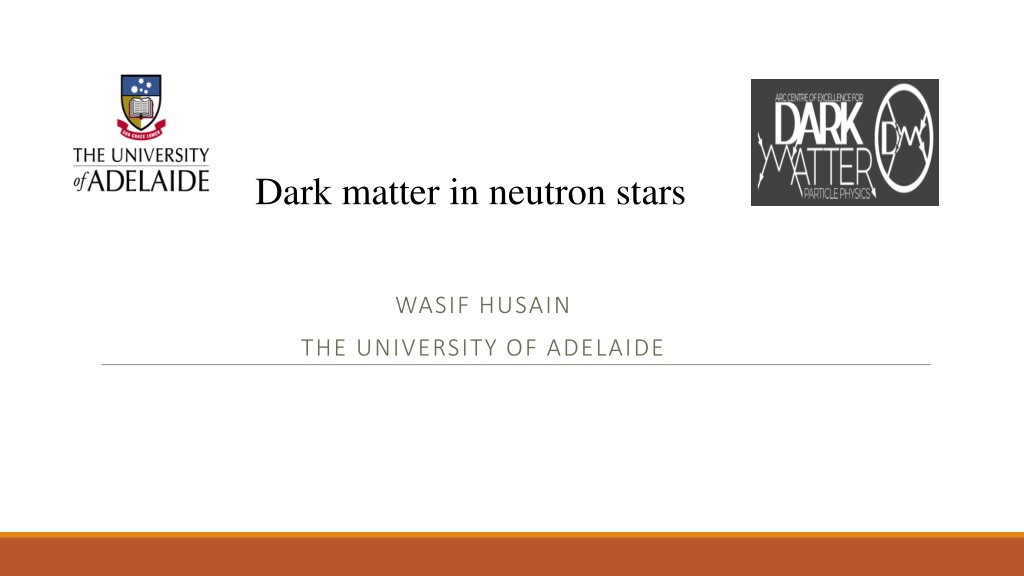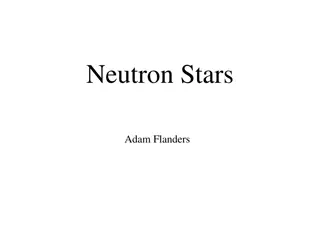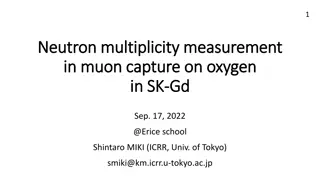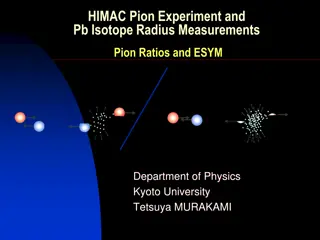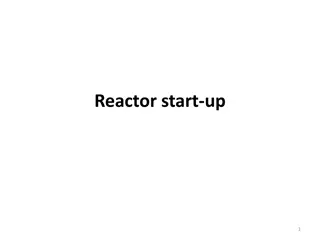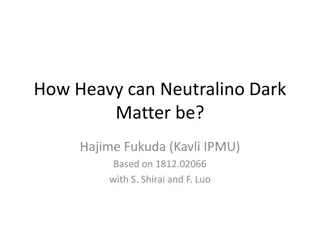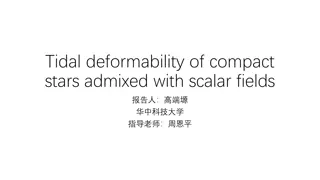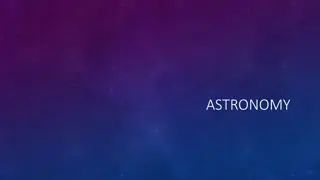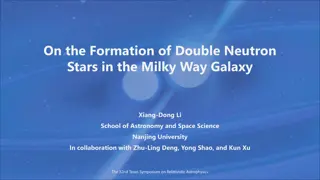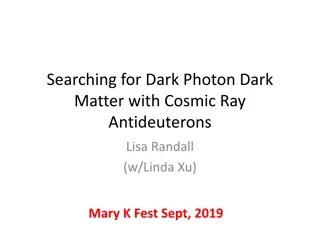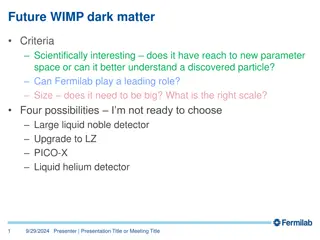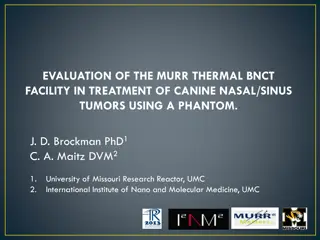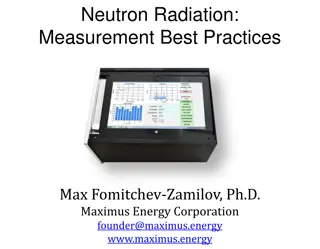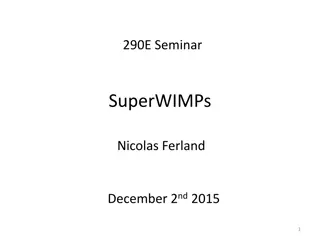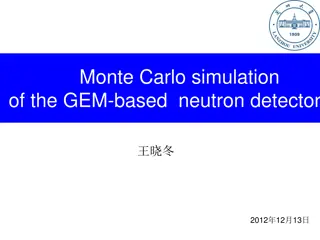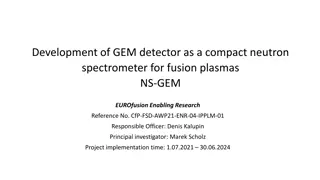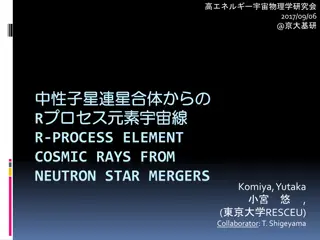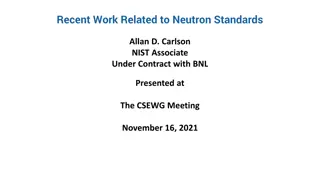Exploring Dark Matter in Neutron Stars
Investigate the interaction of dark matter within neutron stars, comprising approximately 25% of the universe's total matter. The nature of dark matter assumptions, its distribution within neutron stars based on fermionic or bosonic properties, and the implications for self-interacting fermionic and bosonic dark matter equations of state are explored. Neutron stars serve as astrophysical laboratories, enabling the study of physics under extreme conditions, with observational constraints guiding models for ordinary matter. The maximum mass and radius constraints for neutron stars, along with tidal deformability considerations, further enhance our understanding of these enigmatic celestial objects.
Download Presentation

Please find below an Image/Link to download the presentation.
The content on the website is provided AS IS for your information and personal use only. It may not be sold, licensed, or shared on other websites without obtaining consent from the author. Download presentation by click this link. If you encounter any issues during the download, it is possible that the publisher has removed the file from their server.
E N D
Presentation Transcript
Dark matter in neutron stars WASIF HUSAIN THE UNIVERSITY OF ADELAIDE
Abundance of DM DM constitutes the approximately 25% of the total matter present in the universe. DM does not interact with ordinary matter except through gravity Neutron stars and other compact objects can accrete DM. In a cold neutron star DM must settle inside it.
DM assumptions DM has a particle nature. DM is self- interacting.
Does DM always sit inside the core? Depends on the nature of the DM. If DM is fermionic then it cannot condense and might spread all over the neutron star? If DM is bosonic it must condense in the core.
Fermionic DM Construct a self-interacting fermionic DM Equation of state (EoS) using similar approach to a vector meson exchange in the hadronic matter
Bosonic DM Below a critical temperature all particle must condensate. For a dilute gas of bosonic particles at such low temperature, only binary collisions at low energy are relevant, which are characterized by scattering length (la) parameter. Construct an EoS for self-interacting bosonic DM
Neutron stars - Astrophysical laboratories - Physics at extreme conditions - Select model for ordinary matter at extreme conditions. - Have some observational constraint.
Selected models for neutron star for ordinary matter Neutron star contains nucleons only matter (N- QMC700) Neutron star contains nucleons and hyperons (F- QMC700) Neutron star contains nucleons and strange matter (Deconfined quark matter)
Neutron star must have a maximum mass of at lease 2 solar masses Radius should be 9-13 kms for neutron stars. Constraints Tidal deformability must follow gravitational wave observational constraint ( = 400-800) for neutron star of 1.4 solar masses.
Two fluid structural equation Construct a TOV equation for two fluids.
Solve Fermionic DM EoS + ordinary matter EoS + Structural equation Bosonic DM EoS + ordinary matter EoS + Structural equation
Constraint on DM Select properties for DM particles. mx = 1 GeV la = 1 fm (Bosonic DM) mI = 100 MeV (Fermionic DM) Select how much DM mass a neutron star contains. Does the selected properties of the DM particles follow the constraints on the neutron star?
NUCLEONS ONLY EOS WITH DM MASS VS RADIUS MASS VS RADIUS
HYPERONS INCLUDED EOS WITH DM MASS VS RADIUS MASS VS RADIUS
STRANGE MATTER EOS WITH DM MASS VS RADIUS MASS VS RADIUS
NUCLEONS ONLY EOS WITH DM MASS VS TIDAL DEFORMABILITY DEFORMABILITY MASS VS TIDAL
HYPERONS INCLUDED EOS WITH DM MASS VS TIDAL DEFORMABILITY DEFORMABILITY MASS VS TIDAL
STRANGE MATTER EOS WITH DM MASS VS TIDAL DEFORMABILITY MASS VS TIDAL DEFORMABILITY
Distribution of DM inside neutron stars Energy density distribution of bosonic DM when DM contributes to the 5% of the total neutron star mass.
Distribution of DM inside neutron stars Energy density distribution of bosonic DM when DM contributes to the 5% of the total neutron star mass. 220.3 km 223.47 km 225.9 km
Future work - It may be interesting to see the gravitational lensing of neutron star: might an insight of DM distribution inside neutron star and we could have a signal regarding the DM nature. - Make DM mass contribution to neutron star more realistic by constructing a Neutron star DM accretion model, get the age a neutron star and test how much DM it may has accreted.
Thank You Any Questions?
